|
Is a Man Without a Mustache Truly a
Man?
QUESTION:
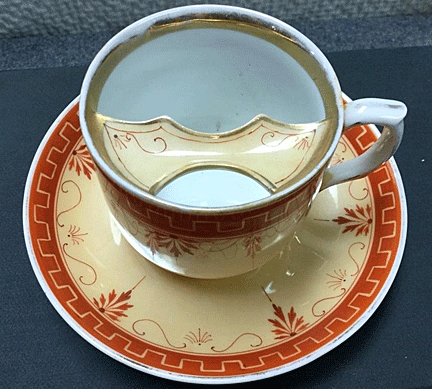 I’ve
seen several mustache cups at recent antiques shows. I’d like to
start collecting them, but the ones I saw were a little pricey.
Before I invest in any, I’d like to know more about them. Can
you help me? I’ve
seen several mustache cups at recent antiques shows. I’d like to
start collecting them, but the ones I saw were a little pricey.
Before I invest in any, I’d like to know more about them. Can
you help me?
Thanks,
Edward
____________________________________________________
ANSWER:
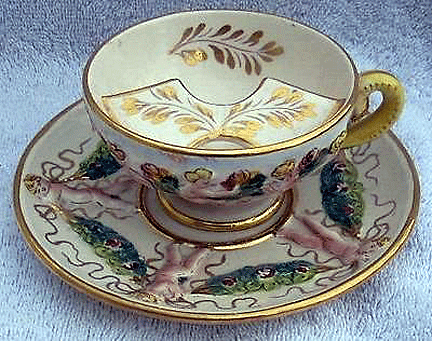 That’s
only understandable. Too many people start collections on impulse and
then things get out of hand. Before they know it, they’ve spent way more
money than they had expected. That’s
only understandable. Too many people start collections on impulse and
then things get out of hand. Before they know it, they’ve spent way more
money than they had expected.
Mustache cups, which featured a raised guard attached to a cup’s rim to
prevent the mustache from touching the liquid, resulted fro a need of
mustache wearers to protect their mustaches. During Victorian times,
mustaches became a form of male pride, with some men going to extreme
lengths to grow a perfect one. Some curled, waxed, and touched up their
mustaches with dye while others used rollers and nets to hold the curl
at night. To maintain and shape these manly growths, men had to use a
special wax.
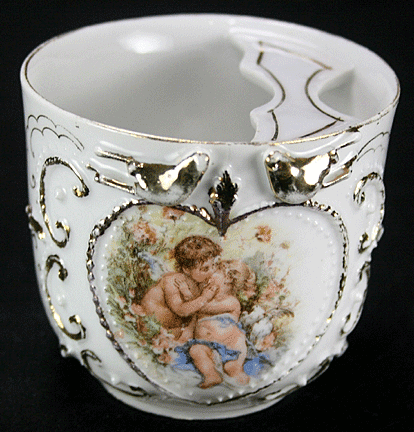 The
wax created a problem for men wearing mustaches because any cup of hot
tea or coffee melted the wax and dripped it right into the cup and
leaving the mustache a drooping mess, and the drink far from tasty. The
solution was the invention of the mustache cup by Harvey Adams in 1830
at a pottery in Longton, Stoke-on-Trent, England. The
wax created a problem for men wearing mustaches because any cup of hot
tea or coffee melted the wax and dripped it right into the cup and
leaving the mustache a drooping mess, and the drink far from tasty. The
solution was the invention of the mustache cup by Harvey Adams in 1830
at a pottery in Longton, Stoke-on-Trent, England.
Victorians began referring to mustaches as "Napoleons," named after the
French soldiers who wore small beards and mustaches called "Napoleons"
after the Franco-Prussian War. During the battle of Waterloo in England
in 1815, most young cavalry officers wore mustaches. The phrase "old
mustache" originated in referring to a soldier during this time. The
English wore long and drooping mustaches called "Piccadilly weepers."
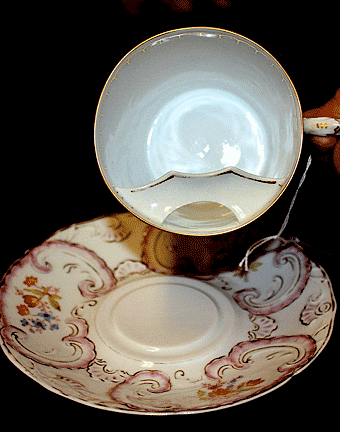 Among
the aristocracy, each gentleman had his own china maker, whose identity
was carefully shielded. The guard across the top was designed from a
mold in the exact shape and size of the nobleman's mustache. Among
the aristocracy, each gentleman had his own china maker, whose identity
was carefully shielded. The guard across the top was designed from a
mold in the exact shape and size of the nobleman's mustache.
During the early years, manufacturers sold mustache cups and matching
saucers as individual items, but as the 19th century progressed, makers
included them in complete sets of porcelain dinnerware, such as Haviland.
Those belonging to the sets were usually small and dainty while those
for everyday use were large and heavy. Men used them to drink coffee,
tea, and even hot chocolate.
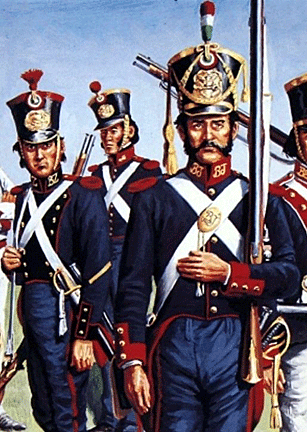 Mustache
cups became popular in the U.S. during the mid 19th century. Mustaches
were popular with soldiers in the United States, also, especially during
the war with Mexico in 1846-48. During the Gold Rush, men found it
difficult to shave because of the rugged lifestyle. The handlebar was
the rage in the Gay Nineties and was satirized in the song by Stephen
Foster and George Cooper, "If You've Only Gocupt a Mustache." Mustache
cups became popular in the U.S. during the mid 19th century. Mustaches
were popular with soldiers in the United States, also, especially during
the war with Mexico in 1846-48. During the Gold Rush, men found it
difficult to shave because of the rugged lifestyle. The handlebar was
the rage in the Gay Nineties and was satirized in the song by Stephen
Foster and George Cooper, "If You've Only Gocupt a Mustache."
German potters produced vast quantities of mustache cups for export to
the U.S. By the 1880s and well into the 1890s, potteries all over the
world had begun producing elaborately decorated sets.
Potters used their imagination to create unique and fascinating mustache
cups and saucers from earthenware; porcelain, and stoneware in many
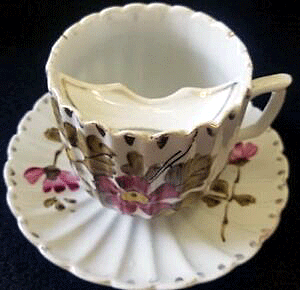 shapes
and sizes, ranging from tiny demitasse cups to large farmer's cups
holding up to a quart of liquid. Tinsmiths and silversmiths also made
them. shapes
and sizes, ranging from tiny demitasse cups to large farmer's cups
holding up to a quart of liquid. Tinsmiths and silversmiths also made
them.
Early cups were bowl-shaped, cylindrical, six or eight-sided, ribbed,
melon-shaped and kettle-shaped. Handles came in many different forms,
ranging from snakes, insects, birds, twisted ropes, fans, and cherubs.
The saucers matched or harmonized with the cups in both shape and
decoration. Early saucers were deep, while later examples became
shallower, like regular saucers.
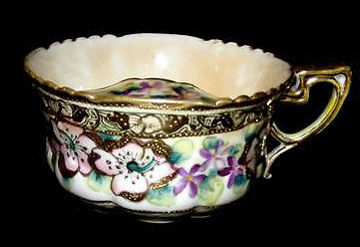 German
manufacturers used luster grounds, which were Victorian favorites, on
their mustache cups. Pink luster was the most popular. Other ground
colors frequently used included pale green, yellow, sky blue, lavender,
coral, cobalt and gold. In addition, German potters encrusted their cups
with ornate forms of applied decoration. German
manufacturers used luster grounds, which were Victorian favorites, on
their mustache cups. Pink luster was the most popular. Other ground
colors frequently used included pale green, yellow, sky blue, lavender,
coral, cobalt and gold. In addition, German potters encrusted their cups
with ornate forms of applied decoration.
Mustache cups can be found decorated with landscapes, hunting scenes,
animals and birds, flowers and interesting geometric designs. Portrait
mustache cups are rare and therefore highly sought after by collectors.
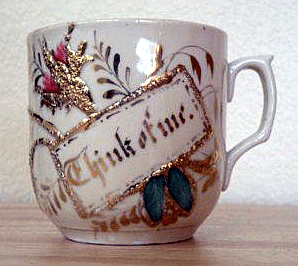 During
in the late 19th century, mottoes or expressions on mustache cups,
written in enamel, gold, or molded in relief, became a fad. Some
examples include “Remember Me,” “Love the Giver,” “Forget Me Not,” “A
Present,” and “Birthday Greetings.” Others had the words “Father” or
“Papa” written on them. During
in the late 19th century, mottoes or expressions on mustache cups,
written in enamel, gold, or molded in relief, became a fad. Some
examples include “Remember Me,” “Love the Giver,” “Forget Me Not,” “A
Present,” and “Birthday Greetings.” Others had the words “Father” or
“Papa” written on them.
Victorians loved to travel, so the mustache cup became a favorite
souvenir. Cups, often with a pink luster ground, could be found in shops
near tourist spots. Manufacturers also made mustache cups to commemorate
historical events and royal coronations.
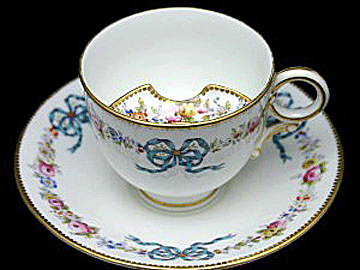 Potteries
in Staffordshire, England, decorated some of these souvenir mustache
cups with transfer printed designs, but today, these are scarce and
command high prices. Matched cups and saucers made by Limoges,
Rosenthal, Royal Worcester and Royal Bayreuth are also becoming hard to
find. Silver-plated mustache cups and saucers in good condition are also
rare. Prices for these rarer cups can reach as high as $400 to $500. Potteries
in Staffordshire, England, decorated some of these souvenir mustache
cups with transfer printed designs, but today, these are scarce and
command high prices. Matched cups and saucers made by Limoges,
Rosenthal, Royal Worcester and Royal Bayreuth are also becoming hard to
find. Silver-plated mustache cups and saucers in good condition are also
rare. Prices for these rarer cups can reach as high as $400 to $500.
Mustache cups reached their peak of popularity during the 1890s, but
were made well into the first quarter of the 20th century. One of the
last times mustache cups were advertised in this country for practical
use was in a Sears Roebuck catalog in 1904.
<
Back to Readers Ask Archives
Next Article > |
